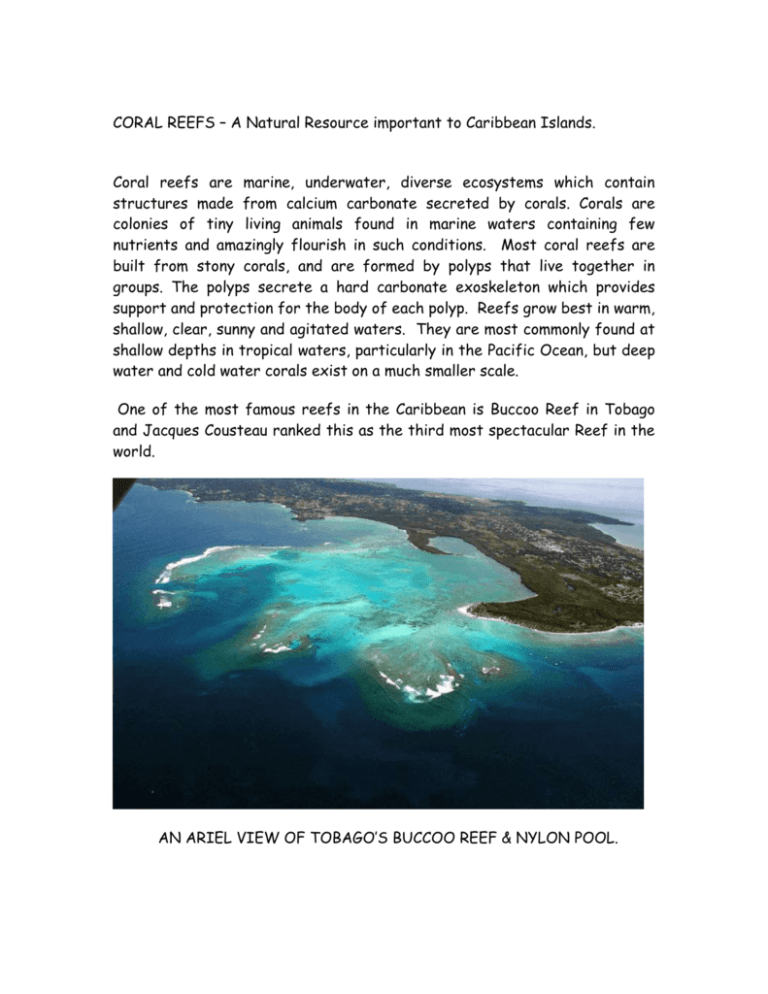Coral reefs are underwater structures made from calcium carbonate
advertisement

CORAL REEFS – A Natural Resource important to Caribbean Islands. Coral reefs are marine, underwater, diverse ecosystems which contain structures made from calcium carbonate secreted by corals. Corals are colonies of tiny living animals found in marine waters containing few nutrients and amazingly flourish in such conditions. Most coral reefs are built from stony corals, and are formed by polyps that live together in groups. The polyps secrete a hard carbonate exoskeleton which provides support and protection for the body of each polyp. Reefs grow best in warm, shallow, clear, sunny and agitated waters. They are most commonly found at shallow depths in tropical waters, particularly in the Pacific Ocean, but deep water and cold water corals exist on a much smaller scale. One of the most famous reefs in the Caribbean is Buccoo Reef in Tobago and Jacques Cousteau ranked this as the third most spectacular Reef in the world. AN ARIEL VIEW OF TOBAGO’S BUCCOO REEF & NYLON POOL. The three most commonly found reefs include: Fringing reefs – reefs that are directly attached to a shore or borders it with an intervening shallow channel or lagoon. Barrier reefs – reefs separated from a mainland or island shore by a deep lagoon and Atoll reefs – more or less circular or continuous barrier reefs extending all the way around a lagoon without a central island. Often called “rainforests of the sea”, coral reefs occupy less than 1% of the world’s ocean surface, yet they provide a home for 25% of all marine species. Reefs are home to a large variety of other organisms, including fish, seabirds, sponges, Cnidarians (which includes some types of corals and jellyfish), worms, crustaceans (including shrimp, cleaner shrimp, spiny lobsters and crabs), molluscs (including cephalopods), echinoderms (including starfish, sea urchins and sea cucumbers), sea squirts, sea turtles and sea snakes. Aside from humans, mammals are rare on coral reefs, with visiting cetaceans such as dolphins being the main exception. A few of these varied species feed directly on corals, while others graze on algae on the reef and participate in complex food webs. ANIMALS FOUND IN CORAL REEFS Generally, fish that swim in coral reefs are as colorful as the reef itself. Examples are the beautiful parrotfish, angelfish, damselfish, and butterfly fish. At night, some change to a less vivid color. Other fish groups found on coral reefs include groupers, grunts and wrasses. Over 4,000 species of fish inhabit coral reefs. Coral reefs deliver ecosystem services to tourism, fisheries and shoreline protection. The annual global economic value of coral reefs has been estimated at $30 billion. However, coral reefs are fragile ecosystems, partly because they are very sensitive to water temperature and salinity. Almost 60% of the world’s reefs are threatened by human activities including coastal development, destructive fishing practices such as blast fishing and cyanide fishing for aquarium fish, over exploitation of resources and marine pollution. They are under threat from climate change, global warming, ocean acidification, and harmful land-use practices. High nutrient levels such as those found in runoff from agricultural areas can harm reefs by encouraging excess algae growth. Reefs are also smothered by silt from soil erosion, and red mud bauxite waste, dust and cement from land construction. Coral reefs are also destroyed by anchors and visitors of the reef who break off coral as souvenirs. Scientists estimate that 10% of the world's reefs have been completely destroyed, while another 30% are threatened. In the Philippines, where coral reef destruction is the worst, over 70% have been destroyed and only 5% can be said to be in good condition. What has happened to destroy all of the reefs? Humans have happened. Damaged coral reefs. The most obvious sign that coral is sick is coral bleaching. That is when either the algae inside die, or the algae leave the coral. The algae are what give coral its color, so without the algae the coral has no color and the white of the limestone shell shines through the transparent coral bodies. People have been noticing coral bleaching since the turn of the century, but only since the 1980s has it gotten really bad. The image above shows an undamaged, healthy coral reef and a bleached reef. If we do not make immediate efforts to save our coral reefs, they will not be there for future generations to enjoy. We have the responsibility of caring for our environment and making sure that we hand it over to future generations in a good condition. If we do not save our coral reefs then we face the following possible consequences: severe damage to our coastlines from tropical storms, marine food webs would be threatened and many fish species will die eventually affecting the species fished for food and ecotourism would decline and this could affect the country’s economy. As a country, we can educate our citizens about the importance of coral reefs. This could be done via documentaries, pamphlets, newspaper articles and workshops in the various parts of the country. The government should pass laws prohibiting reef visitors from removing coral and only allowing trained tour guides to take people to the reef. They also need to ensure that pollution is minimized by providing proper sewage treatment, demanding that farmers use only as much fertilizer and pesticide as needed, conserve soil through crop rotation, replanting trees after harvesting to prevent “runoff” and limiting deforestation. We could further reduce pollution by replacing fossil fuels with alternative sources of energy such as wind energy and implementing the three Rs, reduce, reuse and recycle. We have the power to make a difference. Submitted by Samantha Ramphal, 1J.






